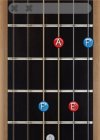snarf
making guitars wish they were still trees
New question for my theory amigos.
I was playing this chord the other day, and the following conversation ensued.
buddy: What's the diminished chord you're playing? I can't seem to figure out the voicing.
me: It's not diminished. It's an F#m6.
buddy: show me.
me: <shows pic of chord below>
buddy: That's not F#m6, that's a weird way to play F#dim.
me: It's F#m6.
buddy: It's diminished.
me: It's minor 6.
<ad infinitum until we shut up about it>
So which is it? Is it F#m6 or a weird way to play F#dim? Or is it one of those things like read and read (I decided to read the second book in the series after I read the first) where it totally depends on the context and could be either?
In this instance, the song is in C, and the immediate progression is F to the chord in question leading back to C.

I was playing this chord the other day, and the following conversation ensued.
buddy: What's the diminished chord you're playing? I can't seem to figure out the voicing.
me: It's not diminished. It's an F#m6.
buddy: show me.
me: <shows pic of chord below>
buddy: That's not F#m6, that's a weird way to play F#dim.
me: It's F#m6.
buddy: It's diminished.
me: It's minor 6.
<ad infinitum until we shut up about it>
So which is it? Is it F#m6 or a weird way to play F#dim? Or is it one of those things like read and read (I decided to read the second book in the series after I read the first) where it totally depends on the context and could be either?
In this instance, the song is in C, and the immediate progression is F to the chord in question leading back to C.



